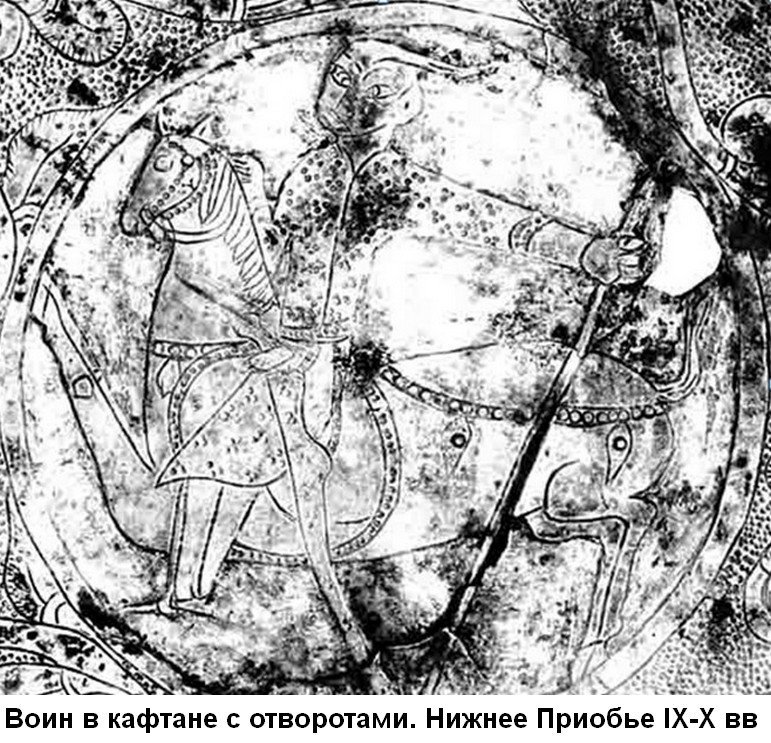Try Amazon Audible Plus

Shop Amazon - Create an Amazon Baby Registry
Horseman in kaftan with lapels, 9th-10th centuries
found at Lake Nanto (Lower Ob River valley) (Yamal Peninsula) near the Yuribey River, Northwest Siberia.

A larger image of this Horseman in kaftan with lapels, Lower Ob River region. 9th-10th centuries.
Воин в кафтане с отворотами. Нижнее Приобье IX-X вв
53. Bowl with the image of a horseman.
Silver, gilding. Diameter 17.7-18, height 3.8. Hungarians during their stay in Eastern Europe, IX century.
Found at Nanto Lake at the River Yuribey. Stored in the Yamalo-Nenets Regional Museum of Local Lore, Salekhard, inv. No. OF 1120/26.
Thin-walled forged bowl, silver surface with small tubercles. Deep contours create subtle relief.
The gilding is uneven, in places it has disappeared.
...
The rider in the medallion is positioned so that the handle of the vessel is above his head; it is possible that it also served to hang the bowl.
The position of the horse's legs and tail, the rider's spear, and his head are such that in many places they touch the edge of the medallion, being quite evenly located.
This feature, as well as the inclined position of the horse's back, as if falling to the ground, resembles Hungarian openwork round pendants with more stylized horses (for example, Fodor, 1975, Pl. XLV, figs. 48, 49), although there are no riders on them.
The hind legs are slightly bent; straight front ones - reared.
The composition itself with an ornamental belt around medallions with figures is well known in the Islamic art of the Middle East (cf. cat. No. 65) and in the metal of the Volga.
Bulgaria (cf. cat. No. 33).
A rider with a wide face and slanted eyes, his hair is with a long forelock. He has no mouth.
This deliberate incompleteness in the rendering of facial features is apparently connected with magical ideas (about them see cat. No. 54).
The rider holds the spear, like a banner, almost vertically, with the tip up in his left hand. In his right he has a horse's rein. This position of the spear is unusual.
In Islamic art from the VIII century to X-XI centuries there are similar poses, but the spear point is turned down and the spear serves to stab the animal located below (Balashova, 1940; Marschak, 1986, Abb. 203 - mirror image - this is a view from the back side).
Suspended from the rider's belt is a Hungarian-type sabre, similar in details and proportions, in particular, to the famous sabre of the Viennese treasury, which received the unreasonable name of "Charlemagne's sabre".
The caftan fastens at the front with a cutout opening the throat angle.
The ornament of the caftan consists of three punson circles placed in groups - the motif of a leopard skin, known in the Central Asian toreutics of the 9th-10th centuries.
The hem of the caftan forms an acute angle at the front at the bottom. Its bottom edge is given by a graceful wavy line.
The cuff on the left arm is long. The bracelet and the upper border of the cuff are filled with a row of small punson circles.
High boots with a side seam, the leg is inserted into the stirrup, the toe is sharp. The blanket is oval. A saddle with a pronounced back bow.
Chest and tail straps with almond shaped harnesses. The bit seems to be strict, with a lever. The mane is rendered in separate, sharpened strands. The tail is lifted up.
To decorate the fringe, blanket, belt, harness belts and to convey eyes, two round punches of different sizes are used.
The larger one means the iris of the human eye, the plaque at the intersection of the bridle straps and the ornament of jewelry on two harness pendants.
There are several options for using punches that allow you to diversify the texture: a continuous row, the same row between two lines, single circles, groups of three, continuous uniform background padding (in the ornament belt).
The peculiarities of the bowl, which are not known from other vessels, include the horse's legs that almost cover each other.
In this respect, both pairs of legs are equally transmitted, as the front.
Source: Plate 53, "Treasures of the Ob Basin." Formika Editor B. I. Marschak. 1996.228
See also a Sogdian split tapestry (kilim) coat with animal motifs, Central Asia, 9th/10th Century
A 9th-10th Century Persian Wall Painting, Palace of Sabzpušan at Nišapur, Saffarid or Samanid Period
Illustrations of Hungarian Costume & Soldiers
Other 9th Century Illustrations of Costume & Soldiers

